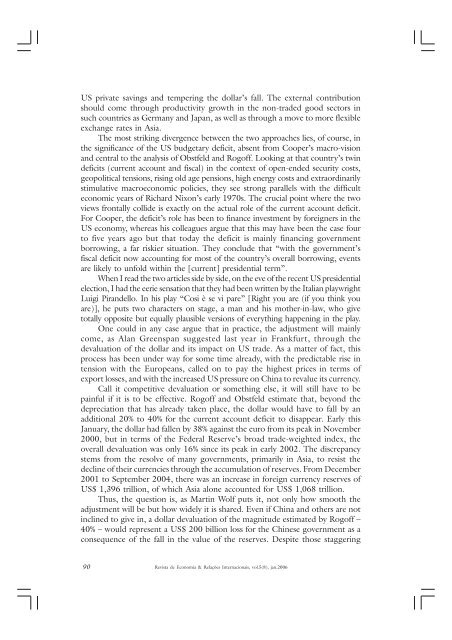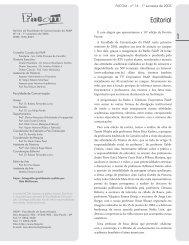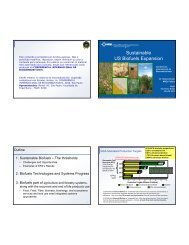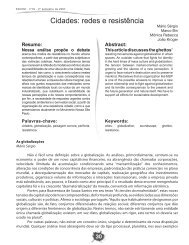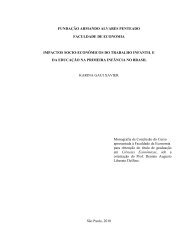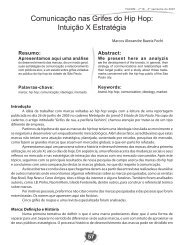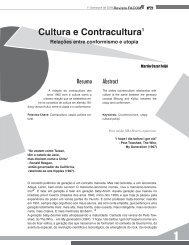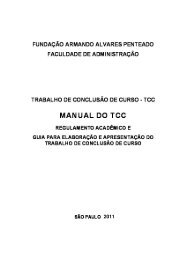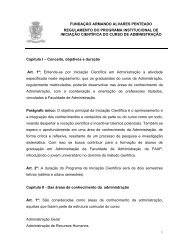Número 8 - Janeiro 2006 - Faap
Número 8 - Janeiro 2006 - Faap
Número 8 - Janeiro 2006 - Faap
You also want an ePaper? Increase the reach of your titles
YUMPU automatically turns print PDFs into web optimized ePapers that Google loves.
US private savings and tempering the dollar’s fall. The external contribution<br />
should come through productivity growth in the non-traded good sectors in<br />
such countries as Germany and Japan, as well as through a move to more flexible<br />
exchange rates in Asia.<br />
The most striking divergence between the two approaches lies, of course, in<br />
the significance of the US budgetary deficit, absent from Cooper’s macro-vision<br />
and central to the analysis of Obstfeld and Rogoff. Looking at that country’s twin<br />
deficits (current account and fiscal) in the context of open-ended security costs,<br />
geopolitical tensions, rising old age pensions, high energy costs and extraordinarily<br />
stimulative macroeconomic policies, they see strong parallels with the difficult<br />
economic years of Richard Nixon’s early 1970s. The crucial point where the two<br />
views frontally collide is exactly on the actual role of the current account deficit.<br />
For Cooper, the deficit’s role has been to finance investment by foreigners in the<br />
US economy, whereas his colleagues argue that this may have been the case four<br />
to five years ago but that today the deficit is mainly financing government<br />
borrowing, a far riskier situation. They conclude that “with the government’s<br />
fiscal deficit now accounting for most of the country’s overall borrowing, events<br />
are likely to unfold within the [current] presidential term”.<br />
When I read the two articles side by side, on the eve of the recent US presidential<br />
election, I had the eerie sensation that they had been written by the Italian playwright<br />
Luigi Pirandello. In his play “Cosi è se vi pare” [Right you are (if you think you<br />
are)], he puts two characters on stage, a man and his mother-in-law, who give<br />
totally opposite but equally plausible versions of everything happening in the play.<br />
One could in any case argue that in practice, the adjustment will mainly<br />
come, as Alan Greenspan suggested last year in Frankfurt, through the<br />
devaluation of the dollar and its impact on US trade. As a matter of fact, this<br />
process has been under way for some time already, with the predictable rise in<br />
tension with the Europeans, called on to pay the highest prices in terms of<br />
export losses, and with the increased US pressure on China to revalue its currency.<br />
Call it competitive devaluation or something else, it will still have to be<br />
painful if it is to be effective. Rogoff and Obstfeld estimate that, beyond the<br />
depreciation that has already taken place, the dollar would have to fall by an<br />
additional 20% to 40% for the current account deficit to disappear. Early this<br />
January, the dollar had fallen by 38% against the euro from its peak in November<br />
2000, but in terms of the Federal Reserve’s broad trade-weighted index, the<br />
overall devaluation was only 16% since its peak in early 2002. The discrepancy<br />
stems from the resolve of many governments, primarily in Asia, to resist the<br />
decline of their currencies through the accumulation of reserves. From December<br />
2001 to September 2004, there was an increase in foreign currency reserves of<br />
US$ 1,396 trillion, of which Asia alone accounted for US$ 1,068 trillion.<br />
Thus, the question is, as Martin Wolf puts it, not only how smooth the<br />
adjustment will be but how widely it is shared. Even if China and others are not<br />
inclined to give in, a dollar devaluation of the magnitude estimated by Rogoff –<br />
40% – would represent a US$ 200 billion loss for the Chinese government as a<br />
consequence of the fall in the value of the reserves. Despite those staggering<br />
90 Revista de Economia & Relações Internacionais, vol.5(8), jan.<strong>2006</strong>


